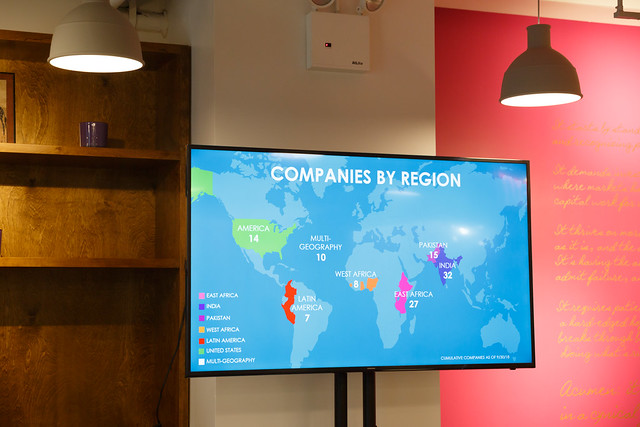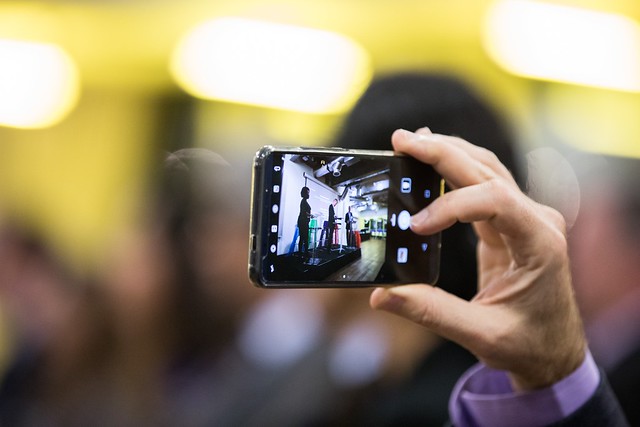Build Your Business
Spotlight your social impact brand with strategic content and communications
Advice from Mandy Gardner, Senior Writer & Brand Journalist, and Justin Belleme, Founder of JB Media Group, on how to cut through the noise so your social impact brand can shine.
March 15, 2019
As consumers, everyday we are bombarded with information from organizations seeking our attention. On the other side, when you’re actively invested in the mission of one of these organizations, you know how vital it is to build meaningful connections with those you want to serve.
How can your organization craft messages that resonate deeply with your audience, build trust, and stimulate engagement?
We recruited Mandy Gardner and Justin Belleme of JB Media Group to answer your questions about how content and communications can support the visibility and growth of your social venture or entrepreneurial nonprofit.
1. How do content and communications fit into overall brand strategy?
Developing your organization’s brand means making decisions about how you want to be seen. Think of every piece of content you share and every communication that comes from your organization as a pixel that makes up the overall image you will project to the world.
Brands create content to attract their target audiences through various channels including search engines, social media, and digital advertising. “Content” encompasses blog posts, videos, infographics, webinars, and email campaigns. You must have a strong brand identity (voice, key messages that establish your unique value, and target audiences) in place in order to develop an effective strategy for developing and distributing your content.
Some common elements of a brand strategy include:
- Target Audiences - The people you want to reach, engage, and attract. Most companies have two to three primary target audiences.
- Brand Promise - A distilled statement about what your company promises to deliver your target audiences.
- Key Messages - Important differentiators that make your company unique.
- Brand Values - The values that your business adheres to. At JB Media we have defined our company values as: Purpose, Entrepreneurial Mindset, Our Client’s Best Interest, Relationships, Balance, and Long-Term Outlook.
- Brand Voice - This is the tone, personality, and style of all communications coming from your company. Having an established brand voice ensures consistency across all marketing and communications channels.
- Brand Positioning - A description of how your company fits into its market, including how it solves key problems for its customers.

2. What steps should I take to discover and get comfortable with my unique brand voice?
In order to distill your unique brand voice, your team must make decisions about who you are and who you are not. Here is a five-step process you can use to discover and codify your brand voice.
Step 1:
Choose a facilitator to lead the process. You can name an internal person or a facilitator from outside the organization.
Step 2:
Invite everyone who should be involved to participate in this brand voice conversation.
Step 3:
Determine which questions you want your team to answer. Here are a few example questions to consider:
- What is your brand’s approach to communication with your audiences?
- What voice or tone do you prefer to use with your customers?
- What descriptors, images, or ideas do you always want associated with your brand?
- What descriptors, images, or ideas do you NEVER want associated with your brand?
Step 4:
Your team should give their observations and answers.
Step 5:
Synthesize all gathered information and distill your findings into a formal guide that can be shared with anyone who writes any communications or content on behalf of your organization.
Our content branding guide worksheet, included in JB Media's free digital marketing toolkit, will help walk you through these steps.
You can conduct this process internally, but it is often helpful to hire outside support from a branding specialist to help define your voice and brand strategy. Just as a mirror is a useful tool to help you see your own reflection, an outsider’s perspective can provide insights that lead to conclusions your team may not come to unassisted.

3. What's the best way to think about setting goals to establish my brand through a content strategy?
Here are some trackable metrics that connect brand awareness with content strategy:
- # of followers on key social networks
- # of searches on search engines, such as Google, for your brand name or branded products or services
- # of partnerships where your brand is being exposed to new audiences. This can include other websites that have agreed to publish your content.
- Thought leadership metrics such as:
- Brand mentions on social media
If possible, determine the growth rate over the past year to see what types of content performed best so you know where to place your efforts. You can then set growth goals for the coming year. Track your progress and use that data to guide content marketing and related digital marketing strategies to help grow your brand awareness over time.

4. How do you recommend a brand goes about determining which key messages are best to include in content and communications?
(And is there an 'ideal' or 'maximum' number of key messages for a brand?)
There is no specific “ideal” number of key messages, but you are wise to hone in on a small number of extremely well-crafted messages that highlight your best qualities. Put your efforts toward developing key messages that are most likely to help you connect with your audiences and inspire conversions that will help you achieve your goals for growth.
Here are a few questions your team should consider when developing key messaging:
- What do you do differently from others in your industry?
- What do you do or offer that makes your organization unique?
- What do you do better than anyone else?
- Why do your customers choose your organization over others?
Above all, key messaging must be crafted to appeal to your target audiences while highlighting the best of what you do.

5. What does it mean to establish brand authority through content?
A brand has authority on a subject when its target audiences think highly of that organization and trust what they have to say.
Regularly publishing reliable content (thought leadership, educational material, guides...etc.) that offers high levels of expertise on topics relevant to your industry helps build authority. Trusting your content is one way that potential customers, supporters, or strategic partners will come to trust your brand (and your products or services).
Here are some ways you can produce content that will help build authority, with the most authoritative content types at the top of the list:
- Write a book about a subject that is important to your industry.
- Be featured in a documentary film about your industry.
- Publish a guest column in a major media outlet.
- Get quoted in articles on major media outlets.
- Deliver a keynote lecture at a major industry conference about your area of expertise.
- Appear on a panel at a major industry conference.
- Host a podcast or webinar series with well respected guests and panelists from your industry.
- Author an e-book or series of e-books on topics important to your audiences.
- Establish a large social media following/audience within your industry.
- Write a series of high-quality blogs that share your unique expertise.
- Develop a series of educational videos on YouTube.
These are just a few examples of types of content that help to build brand authority.

6. How can I grow my brand authority as a purpose-driven company?
Brand authority builds over time, in what is typically a fairly slow process that can be accelerated by major media/PR wins, partnerships, high profile speaking opportunities, or if a brand building campaign is highly successful or goes viral.
Purpose-driven companies should also consider partnerships and paid placements with companies and media outlets that align with their purpose and brand values. This will ensure that as the authority builds, it will be building within audiences that are also interested in supporting purpose-driven businesses.
One important thing to consider when building brand authority is the difference between brand authority for business to business (B2B) and business to consumer (B2C) companies.
In building brand awareness, B2B companies are trying to increase authority with buyers and decision makers who are deciding how to spend their business budgets. Therefore B2B brand authority comes from credibility and trust within your industry. A company can have a lot of brand authority in B2B without reaching a very large audience if the focus is placed on only communicating with and creating content and relationships that build trust within the industry target audience.
For B2C companies, the goal of brand awareness is to influence consumers to spend their personal money on your products or services. B2C brand building typically requires a broader marketing strategy. Brand authority within B2C is highly influenced by consumer word of mouth, reviews on public websites, and successful partnerships with other brands that already reach the same audience. Trust and authority can be passed from one business that already has authority to another when two businesses create successful partnerships. B2C brands can also work with individuals who have a large online following through a strategy called influencer marketing. Working with an individual or personal brand that already has a large following to promote your B2C products and services can be one of the fastest ways to build brand authority. However, it takes effort and a solid strategy for a company to build trust and authentic campaigns with influencers.

7. At what stage should someone be thinking about a branding strategy as it relates to written content?
It is never to early to think about how content can help your business build authority, search traffic, and engagement. Focus on efficiently creating content that adds value for your target audiences.
Creating a full brand strategy is not critical for businesses at very early stages. It’s good to go through a basic branding process to establish your brand identity including your logo, color scheme, and brand promise. Depending on the budget and amount of startup capital that a business has, it may also make sense to work on a mission statement, brand values, and an overall brand growth strategy at the beginning. Most businesses. however, do not have all of these elements in place within the first year. Early stage startups are likely to pivot within their business model, target audience, and other factors, so spending a lot of time and money trying to fully articulate those things too early can be wasteful. Having a high level understanding of these elements is enough early on.
Many successful influencers and thought leaders get started by writing a book, podcast, blog, or video series (vlog).
Figuring out the exact brand strategy and monetization can come later in some cases. Of course, this requires the time, energy, and expertise to create great content, and the luxury of waiting until later to figure out how to monetize it.
On the other hand, many small businesses focus first on finding and serving a small number of customers, while failing to establish a solid content development and brand growth strategy. It is possible to succeed by focusing on sales and serving customers first, and it is also possible to succeed by focusing on developing great content first and figuring out the financial side of the business later.
It is my opinion that the best approach is a middle ground where a business spends some time early on creating a simple brand and content strategy while also working to find and serve early customers. This requires a balancing act between marketing and brand building activities alongside sales and product/service delivery, but in most cases this will lead to a sustainable business if the company has found a good product market fit within a profitable niche that has room for growth.

8. What role does storytelling play in content, communications and branding?
Stories captivate us, they move us, they inspire us to action. Stories are memorable.
In digital marketing terms, content that tells a good story is much more likely to invite social sharing, build links, increase site traffic, and convert strangers into friends and fans of your brand. Telling a story that illustrates the challenge you are working to solve, shows your solution in action, or puts a human face on the impact that you are creating will go a long way toward building brand awareness and attracting the people you most need to reach.
If you are working on your own content strategy and are looking for simple advice to follow, here it is: Tell stories about people whose lives were transformed by your solution. Just make sure that whatever story you share is relevant to the audience you want to reach.

9. What are some of your favorite examples of content that does a great job building or supporting brands in the social impact space?
There are so many different kinds of great content being published by amazing organizations that it is difficult to choose specific examples.
Instead of singling out individual pieces, we’ll recommend a few organizations that are creating great content to support organizations and brands across the impact space.
Storytelling for Good, supported by Hattaway Communications and The Rockefeller Foundation, offers valuable lessons on content production for social impact organizations along with articles that highlight great content and tips on what makes that content great.
SOCAP is the leading convener of the impact investing and social entrepreneurship communities. SOCAP has been one of our clients since 2015, and we have produced a variety of interviews and other types of content for them that highlights the stories of members of the SOCAP community and the impact they create in the world.
BALLE is an organization that is spearheading a localism movement that is trying to create equitable, healthy economies in local communities across the United States. Their content does a great job of highlighting the impact they are creating through their Fellowship and other programs.
Echoing Green is a pioneering organization dedicated to creating positive systemic change by funding and supporting innovative entrepreneurs. Their team creates and shares a variety of content that highlights the impact created by the Echoing Green Fellows.
Mandy Gardner is an award-winning writer who is passionate about crafting and sharing stories that change the world for the better. As the the senior writer and brand journalist for JB Media Group, Mandy is experienced writing in many formats across industries and is the lead blogger for Social Capital Markets Group (SOCAP).
Justin Belleme oversees marketing strategy for JB Media Group projects in content marketing, SEO, digital advertising, social media, event marketing, and email campaigns for social enterprises, mission-driven companies, and nonprofits. Justin is a graduate of the StartingBloc Institute and Hive Global Leaders programs and was named Entrepreneurs of the Year by the Asheville Chamber of Commerce in 2014 and was inducted into Asheville’s 40 Under Forty in 2012.
Collectively Justin and Mandy have worked on marketing projects for many of the most recognized organizations in social impact including: SOCAP, Conscious Company Media, the Social Venture Network (SVN), BALLE, and B Lab.
To stay connected with Mandy and Justin, follow JB Media on Facebook or Twitter, or visit www.jbmediagroupllc.com for more information.

Author
Danielle Sutton
Danielle Sutton is the Content Animator at Acumen where she surfaces stories to inspire and activate social entrepreneurs. In an age of information overload, she believes in learning 'the right thing at the right time' to intentionally design impactful social enterprises. You can usually find Danielle digging into the Acumen course library, playing in the mountains, or exploring marketing on The Sedge blog.
.jpg)